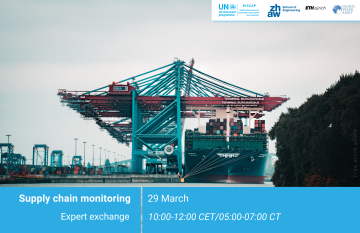
On 29 March 2022 15:00-17:00 (CET), the United Nations Environment Programme (UNEP), Zurich University of Applied Sciences, ETH Zurich, and the Global Trade Alert by the St. Gallen University hosted an online expert exchange among researchers, practitioners, and specialists on the supply chain to discuss the benefits and obstacles of using digital technologies on supply chain risk management and public monitoring.
Experts shared their experiences and insights on current private and public monitoring schemes, describing the current state of play in supply chain monitoring, the digital technologies being applied and the mechanisms used for generating timely insights of environmental risks and environmental impact of supply chains. Additionally, the experts discussed systemic challenges of supply chain monitoring like data generation, collection, processing, and information uptake.
The conversation led to a lively exchange on the future of these monitoring efforts and the potential of digitally connecting environmental monitoring, supply chain traceability and green economy policy transparency.
The experts were:
- Chris West (Deputy Centre Director for Research of the Stockholm Environment Institute and researcher at Trase.earth)
- Maria Ricart (Sustainable Business Developer and Supply Chain Specialist for Vizzuality and Landgriffon Consortium)
- Meike Schröder (Researcher and professor at the Institute of Logistics and Supply Chain Management of the University of Hamburg)
- Susanne Katus (VP Brand and Business Development, Corporate Secretary at Datamaran)
Meeting Agenda
| 15:00 - 15:10 | Welcome and introductions |
| 15:10 - 15:45 | Scoping supply chain monitoring (SCM) |
Each participant (5 minutes per expert) will share their understanding of the goals and scope of supply chain monitoring from their own unique perspective. Their interventions will serve as the basis for a common understanding on the relevance and purposes of these monitoring tools. Some guiding questions include:
For supply chain management (or portfolio management), which are the risks considered? (e.g. financial, regulatory, reputational, physical, etc.) For supply chain transparency purposes, what is the focus of their monitoring activities (e.g. survey environmental impact, regulatory compliance, etc.)?
Is there a capacity of generating visibility over entire supply chains, including lower-tier suppliers and sub-suppliers, namely in cases of transnational supply chain operations? What’s the capacity of identifying hotspots that might endanger the supply chain resilience or be associated with environmental risks? What’s the capacity of identifying relationships between supply chains or assets with the drivers of negative environmental impact? |
|
| 15:45 - 16:30 | Technology readiness and systemic challenges |
| Participants will have an open discussion about technology readiness of improving supply chain monitoring for resilience, risk management and for mitigating environmental impact. This discussion takes into account the development and application of technologies from data generation to data analysis, as well as relevant business models. Experts will also be invited to identify bottleneck problems at the systemic level for the scaling up of technology solutions. Participants will have the opportunity beforehand to express their interest to focus on certain questions or raise new questions to peers in the discussion. | |
|
Supply chain management Data generation, collection and access
Data processing and data analysis
Information uptake
Supply chain transparency Data generation, collection and access
Data processing and data analysis
Information uptake
|
|
| 16:30 - 17:00 | The future of supply chain monitoring |
|
Each expert will have 5 minutes to cover one of the following questions. First, the speaker can make a wishlist for technology solutions for addressing a particular methodology or data treatment issue for monitoring supply chains in a specific sector, taking into account data availability. Second, noting the limits of technologies, the expert is invited to outline the necessary elements of a collaborative mechanism for better data access, data sharing, and to enable the uptake of monitoring intelligence. In particular, the speaker could identify areas of collaboration or raise questions to experts of environmental monitoring and experts of green economy policy monitoring. |
|
Key takeaways of the event and areas of convergence:
- The discussion converged on the key role of digital technologies for monitoring efforts, allowing the integration of sustainability into decision making, accelerating accountability and improving visibility over complex and indirect supply chains.
- Experts emphasized the importance of public data in their line of work and converged on the quality and availability of public data but expressed their concern about the availability of quality data in some places, the lack of standardization, constant changes on data landscape and intense competition from data providers that leads to new products not fit for purpose.
- Several experts coincided on the insufficient access to private data and one central point of the discussion focused around overcoming barriers to data sharing through collaboration, multistakeholder partnerships or even through regulation.
- Experts recognized the struggle for companies relating to methodology, with some of them sharing a concern over building trust around methodologies, especially when it comes to private sector stakeholders that have their own data.
- All experts agreed that the information uptake is driving companies to address the sustainability of supply chains but experts found that this has created new challenges like inconsistencies among datasets, lip service and lack of validation checks, lack of collaboration and funding, and also, challenges on how to use the data for actions that have an impact on the ground.
- Experts differed on the associated issues that must be addressed to improve monitoring. For some, the main need is to collaborate, while for others is underpinning data with robust evidence and science, securing funding, standardizing complex data and building capacity of stakeholders (local communities and small enterprises).
